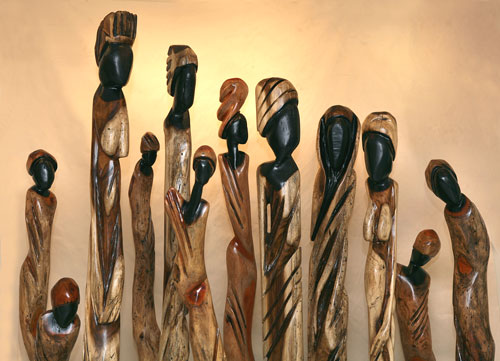|
From:TheBahamasWeekly.com Art Life - Susan Mackay
On Friday, November 9th 2007, over two hundred people attended the opening night of the exhibition.
It was an amazing event, with songs, dance, poetry and speeches - an event that will be recorded in the history of this island.
Thirteen artists (from Nassau and Freeport) exhibited a range of work expressing the artists’ interpretation of the theme—and what a theme to be interpreted!
In a prefacing statement by Erica James, curator of the National Gallery of The Bahamas, she cites the role and immense responsibility of an artist in society to “…stimulate discussion and critique on societal issues.” James tells us that. “…art provides the opportunity to enter and engage very difficult, unspeakable things through the screen and object-hood of aesthetic objects.”
Slavery is an immense topic. As an artist, I was challenged to find a point of reference in my life to explore in this show. I have lived an incredibly privileged life, the only ‘slavery’ I can imagine experiencing is my own dark thoughts and self deprecation,
and the seeming endless slavery to possessions, money, power, and image that is the unrecognised plight of Western society at the cost of our environment (and souls).
However widespread and communal this “mental slavery” may be, here in the relative ease of a ‘free’
After the show was over and the paintings and sculptures had all been taken down, I passed on the side of the road two small metal cages.
The question had been spinning around my head: have we succeeded in this show, in respecting the past in all its tragic and gruesome details and yet, held to some belief in an optimistic future, forged out of that horror?
As a conceptual piece, I wondered if the cages, showing approximately the space that one person was forced to occupy on that endless and excruciating journey across the seas to the ‘New World’, would not have been a more pertinent and realistic expression of one of the terrible degradations slavery inflicted.
Talking to people about slavery seemed to bring up those exact issues of identity, race and colour.
The responses ranged from white people who seemed largely ignorant of the full brutalities and inhuman treatment, to black Bahamians who held the grudge of their ancestors, to men like a friend, whose blended heritage is both slave and master, so he can neither hate nor completely embrace either ‘side’.
The past, I believe, is either a key to the future or a chain shackling us to the past. It is that delicate balance of acknowledging the horrors while still, as John Cox says, “…allowing the ‘psychological transformation’ (that) takes time to evolve even after the law endorses freedom.
The effects of oppression are left for members of a free society to challenge years later.” And though, yes, we are celebrating the ‘freedom’ we have to acknowledge the past enslavement and the current effects of that.
When dealing with this issue its hard not to fall into a feeling of “them” or “us”.
Being white, I feel ashamed, yet is that shame justified?
And in being black, is a continued anger justified?
Even acknowledging the truth that past wrongs are still affecting today’s society, where does the anger about the past that is still felt today go?
How do we step out of such entrenched views around identity?
How do we let go the image of victim? How do we let go the image of superiority? Is there a way that both ‘sides’ of this wide-ranging equation can harness their emotional energy, to forge ahead together in creating a path that truly honours the oneness of the divine and human grace we mirror for each other.
One of the exhibition organisers, Chantal Bethel, shares her view that “…the show was a success in facing this difficult issue, most importantly, by bringing it to the attention of the children.” The week following the opening, busloads of school children, of all ages, came and experienced the show. Claudette Dean, also an organiser of the show adds, “the school children (and there were many) who will never forget the 200th Anniversary of the British Abolition of the Transatlantic Slave Trade because of the power and beauty they witnessed through the art. (Much more effective than a history lesson!) Viewing the show sparked more conversation on slavery, emancipation, freedom, and identity than ever before.”
In considering all the possible challenges of such a potentially controversial and inflammatory topic, it seems that the artists as a group succeeded in bringing a deep respect of that past into valid questions and understanding for society today.
It might have been more comfortable to wash over this ugly piece of history, or indeed, to sensationalise it, but thanks to the Freedom Call organizers, Chantal Bethel and Claudette Dean, as well as the curator, Antonius Roberts, the artists succeeded in portraying a moment in history that needs to be remembered with sensitivity and understanding. The artists brought this painful subject into the present to keep us all conscious and to keep our eyes firmly on the horizon to walk together, irrespective of ANY differences or ancestry or colour or belief or any other tool of separation, into a better future.
Maybe the questions are redundant if we can be left holding one image from the show, that of Omar Smith’s “Event Cosmism Protrusion” the three children embracing the future without prejudice, because surely, if there is one lesson that needs to be learned from the past it is the dignity of humanity that we all possess and must respect in each other.
|
